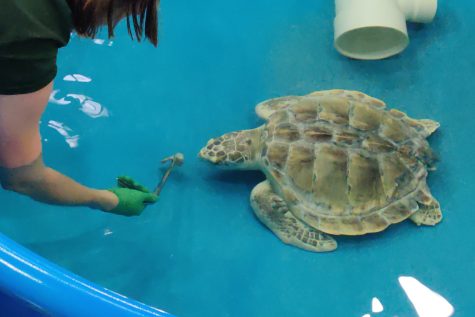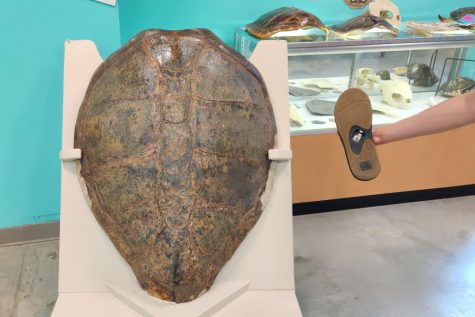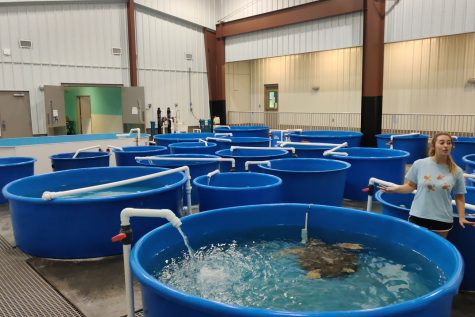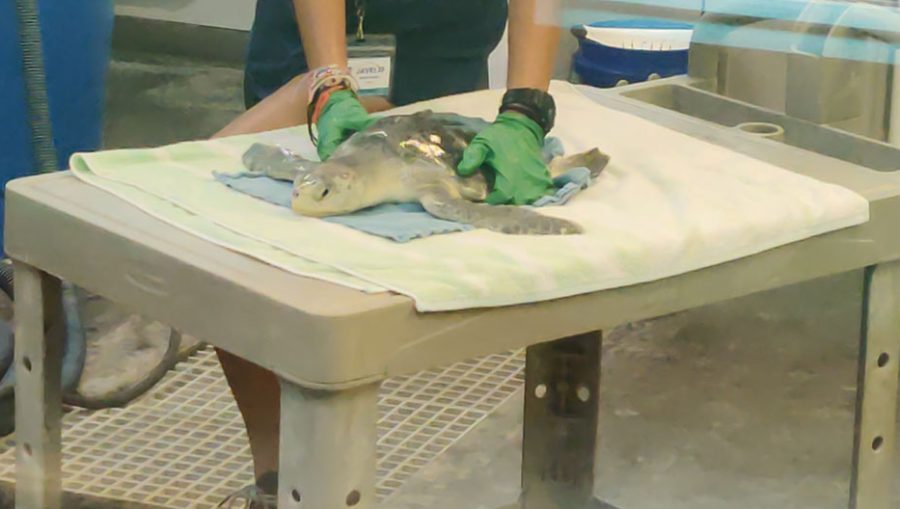Turtles will save us if we let them
A rescued sea turtle is being wheeled into the Sick Bay at the Karen Beasley Sea Turtle Rescue and Rehabilitation Center after receiving a massage.
October 4, 2022

Sea turtles are (probably) the best thing known to man. In addition to being some of the most majestic, beautiful, and adorable creatures on Earth, they provide more good for the oceans than humans do for the whole planet. Protecting, saving, and helping sea turtles needs to be one of the highest priorities for mankind. I visit turtles that have been through man-made horrors beyond their comprehension every year since before I could fit four words in a sentence, turtles that in some cases had been literally glued back together, leaving me with a life-long dedication to helping these creatures in any way I can.
Let’s look at the great things that just three of the seven unique species of sea turtles do:
Green sea turtles are lawnmowers that eat seagrass and algae. Trimming seagrass keeps it healthy, and seagrass provides breeding grounds for fish, shellfish, and crustaceans. It stabilizes the sea bottom and maintains the sea’s water quality. For us on land, seagrasses produce 1 liter of oxygen (ten breaths) per square meter per day. They store twice as much carbon than rainforests in the same amount of space, at 2740 tons of CO2 in just one meter per year. If we plant a ton of seagrass and boost the Green turtle population, our removal of the rainforests
might not kill us. Keep the rainforests, and the atmosphere might not suffocate us.
Hawksbill sea turtles eat sea sponges, which are incredibly toxic to most other sea creatures. Eating the sponge exposes nutrients inside that allow other organisms, like coral reefs, to grow. These reefs give a home to over 1 million different species. Sea life gives the fishing industry billions of dollars and millions of jobs, and also provides much of the food in coastal society (40% of the US population), even more so for small islands that have little land for agriculture. Reefs also provide a natural barrier to protect coastal cities and provide ingredients for treatments doctors believe could fight cancer, arthritis, and more. In addition, reefs also consume loads of CO2. Saving Hawksbills would save coral reefs, and saving coral reefs is a big part of saving the world.

Most turtles will eat jellyfish, but Leatherbacks specialize in them, much like Hawksbills with their sponges, eating twice their ~1000-pound body weight in soft invertebrates each day. Keeping jellyfish populations in check is a necessity, as jellyfish love eating small fish and their eggs. More jellyfish means less fish, and fewer fish means less food, money, jobs, and more for a large part of the population. Plus, getting stung by a jellyfish is no fun. More Leatherbacks mean fewer jellyfish to bother us at the beach, more fish to eat while there, as well as a healthier ocean.
All turtles make a difference on land when they nest, keeping the vital sand dunes in place and feeding many of the more land-based animals on the beach.

When ready to lay, the female sea turtle crawls up in the dead of night from the water to the dune, digs a hole, and lays about one to two hundred eggs, depending on the species. Each egg has about a 40% chance of hatching. Of those hatched eggs, some turtles don’t ever make it out of the hole and are trapped inside. On the way to the ocean, many of the lucky few who succeed in freeing themselves of the hole are eaten by crabs, seabirds, and the like. In a nest of 110 eggs, only about 11 will grow to be adults, according to the Smithsonian. Though this sounds like bad odds for these creatures, consider that only one Hawksbill turtle, by these estimates, has about 10,000 offspring that reach adulthood in its life, 8,850 times that of the average American.
These less fortunate turtles still fulfill an important purpose, they act not only as food for other animals fulfilling their own purpose in the ecosystem, but they also provide a vital fertilizer for vegetation in the sand dunes. Dunes are essentially just piles of sand, so the plants that grow in and on them are necessary to keep the dunes existent. Dunes protect coastal cities from all sorts of natural disasters, without them, coastal cities will be threatened by high tides, winds, sea storms, large waves, and more.
The greatest threat to sea turtles, and by extension us, is ourselves. Nearly all seven species are classified as endangered. In addition to illegal hunting and egg poaching, Turtles often are often hurt by fishing gear, boats, pollution, oil spills, trash (even what goes into the landfill), and more.
52% of all the turtles in the world have ingested plastic.
Even a few degrees of rising global temperature are hurting turtles, as the sex of a turtle is determined by the temperature of the egg. Because the Earth is getting hotter, more and more females are born, along with fewer and fewer males. Greater gender imbalance means fewer turtles are born.
Everyone’s favorite example of turtles suffering, straws, seem to be designed only to hurt and kill turtles with their small and bendable shape that’s impossible for turtles to remove from the perfect fit of their nostrils. Even for a human to remove it, pliers are usually necessary. However, straws alone don’t cause nearly as many deaths as you’ve been led to believe. While straws are painful, they only make up for a fraction of turtle deaths caused by man.
One of the biggest threats to many turtles, especially Leatherbacks, is plastic bags. One trip to Walmart and getting your groceries in plastic is a death sentence to tons of turtles, as a bag floating about near the surface of the water looks a lot like a jellyfish. The turtle, if it doesn’t choke on the bag itself, will never fully digest the plastic and will die of starvation as its stomach, though pumping out no nutrients, will always tell its brain that it’s full.

The best way to start helping turtles is to stop hurting them. After not using plastic, donations to turtle hospitals are good, and a great hospital to donate to is the Karen Beasley Sea Turtle Rescue and Rehabilitation Center in Surf City, NC. I visit them every year during my annual trip out to Topsail Island; I’ve been going out east since before my first birthday, and touring the hospital is always a highlight of the trip. The KBSTRRC allows visitors during the summer to come in and see turtles in rehab, which I have done before I was even able to read. Volunteers at the hospital find, heal, and release these turtles, they protect their nests by covering them in grates and marking them with neon orange tape, they educate the masses about what turtles do in their environment and how to protect them, and more. If you have a few bucks to spare, why not send it their way?
As great of an impact you can have with your wallet, you can have greater with your choices. Don’t use straws, recycle non-biodegradables, use paper bags (or bring your own), and tell others to do the same. Try to get your school, workplace, local restaurants, and so on to switch to compostable straws, cutlery, and cups. Turn off your lights at night if you live on the coast, as sea turtle hatchlings will be attracted to them like moths and go the wrong way. If you’re on the beach, fill in holes as nesting turtles, hatchlings, and even people, can fall in and become hurt, trapped, and/or dead. De Smet students, myself included, cause incredible potential turtle death each day by using the plastic silverware in the cafeteria. No one’s stopping you from bringing your own fork.
Even if for some reason you are a heartless monster who doesn’t care about these modern dinosaurs, the ocean in general, or the increasing amount of greenhouse gasses melting the Earth, triggering asthma, other respiratory problems, and the lowering amounts of oxygen that give us life and enable the function of every gram of muscle, organ, and brains in your body, even if you don’t care about all that, you still probably care about not being poisoned. Our reckless dumping of plastics in the ocean has led the food web to cause us to eat a pencil per week in plastic, and one and a half billiard balls a year in weight. This plastic is filled with harmful chemicals like Bisphenol A, pollutants, and other toxins. No matter how you look at it, helping turtles helps us.
Ask the cashier for a paper bag next time.








